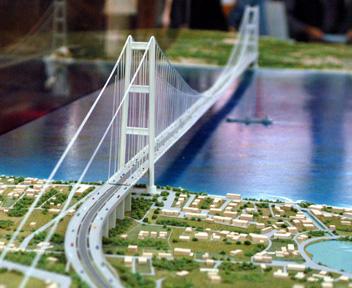words by Carol King
The Italian government has extended feasibility tests for two years on a proposed bridge across the Strait of Messina.
The controversial €8.5 billion project for a road-and-rail bridge had been cancelled by Prime Minister Mario Monti’s technocrat government, citing the need to reduce public spending. The government announced that it had assigned €300 million additional funding for the project should the bridge not be realised in order to satisfy a penalty clause relating to the international consortium of contractors involved in its construction.
The suspension bridge would link the Italian mainland to the island of Sicily across the narrow strait of water, connecting the Calabrian toe of the Italian peninsula to the port of Messina in Sicily. The bridge project has had a tortuous history stretching back decades. In 2006, the project was cancelled because of its “doubtful usefulness and viability” then in 2008, when former premier Silvio Berlusconi returned to power, it was revived.
Constructing the bridge is a major undertaking and would be an engineering feat. The Strait of Messina is subject to strong winds and tidal currents. At 2 miles in length, the bridge would be the longest in the world, mounted on two pillars each higher than the Empire State Building.
Advocates of the bridge say it would increase tourism to Sicily by cutting out the 90 minutes required to load trains from the mainland on to a ferry to the island, and hence income. In addition, ecologically the water would no longer be polluted by ferry traffic, the local economy would get a boost during the construction phase and beyond, and the psychological barrier regarding reaching southern Italy south would disappear.
However, there is debate as to whether the premise is sound given the area’s geology in a region prone to seismic activity: devastating earthquakes hit Messina in 1783, 1894 and 1908. The bridge would be built to withstand an earthquake of 7.1 on the Richter Scale – the maximum ever recorded in Italy. Critics of the project are also concerned about possible infiltration by criminal organisations in the project and suggest that Sicily would be better served by investment into its transport infrastructure.
The environmental group Legambiente has criticised the decision accusing the government to kick the issue down the road for the next administration, keeping the the (pro-bridge) lobby happy while wasting more public money in the meantime on what they consider just further “useless tests”.
The idea for a bridge was first touted in Roman times, when Pliny the Elder considered using a combination of boats and barrels to transport elephants captured from the Carthaginians. Since then, proposals for a bridge have arisen over the centuries.








